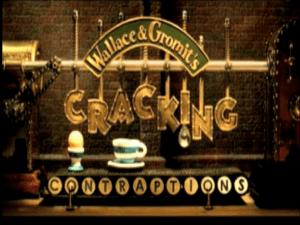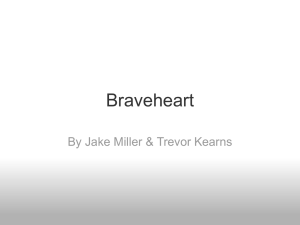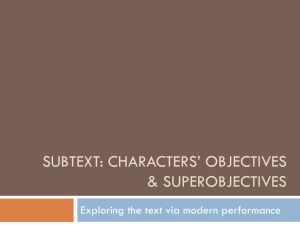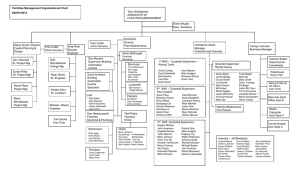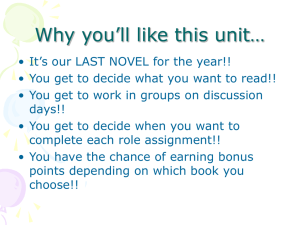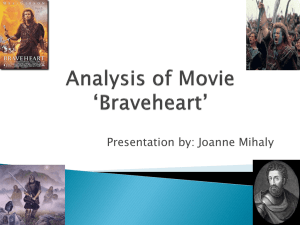the_acting_method_and_reading
advertisement
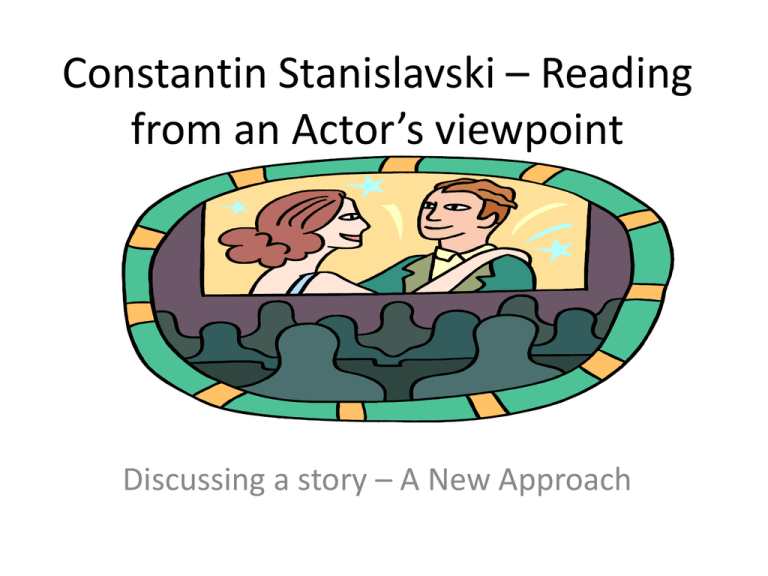
Constantin Stanislavski – Reading from an Actor’s viewpoint Discussing a story – A New Approach Who was Constantin Stanislavski and what is “the Acting method”? • Use your computer to find and paste a workable brief biography, especially concerning his theatre career, in the space below. Also, find a description of the acting system or “method” he developed and place it here. We as “Actors” (readers) will seek to know these things about the story. What is the story’s Super-objective? What is at the center of the story? Whose story is this? What is the through line of action for each of the characters? Which important incidents will we label as turning points? What is each character’s key subtext, motivations, and action? The Magic If… Super-objective Super-objective can be loosely correlated to the theme of the story, but it differs in some ways. Mostly it is more complex. S-0 is the primary motivation of the story, the reason of the story. It is a complex interaction between the situation, setting, and individual agendas of all the characters. It is NOT a simple statement. Continued… Super-objective continued For example, a film we’ve all watched, is Braveheart. The Super-objective of the film might be expressed thusly: Braveheart is the story of two men and a woman, Wallace, Robert the Bruce, and Princess Isabella and how each struggles to free themselves from the demons possessing them: Wallace from passionate hatred sprung from his love for others, Robert from the desperate family search for power that he must sacrifice for his country, and Isabella from her joyless, loveless, male-dominated marriage in the English court, and in so doing demonstrate the great feats of sacrifice that individual people can make that benefit others in the name of Freedom. Super-objective continued For example, a film we’ve all watched, is Braveheart. The Super-objective of the film might be expressed thusly: Braveheart is the story of two men and a woman, Wallace, Robert the Bruce, and Princess Isabella and how each struggles to free themselves from the demons possessing them: Wallace from passionate hatred sprung from his love for others, Robert from the desperate family search for power that he must sacrifice for his country, and Isabella from her joyless, loveless, male-dominated marriage in the English court, and in so doing demonstrate the great feats of sacrifice that individual people can make that benefit others in the name of Freedom. Super-objective continued For example, a film we’ve all watched, is Braveheart. The Super-objective of the film might be expressed thusly: Braveheart is the story of two men and a woman, Wallace, Robert the Bruce, and Princess Isabella and how each struggles to free themselves from the demons possessing them: Wallace from passionate hatred sprung from his love for others, Robert from the desperate family search for power that he must sacrifice for his country, and Isabella from her joyless, loveless, male-dominated marriage in the English court, and in so doing demonstrate the great feats of sacrifice that individual people can make that benefit others in the name of Freedom. Through line of action Each character has an agenda. The through line of action for any character is the primary objective or “spine” for each person’s actions. This through line of action carries him/her/it towards their basic goal. For the story to succeed, Stanislavski says, “The stream of individual, minor objectives, all the imaginative thoughts, feelings, and actions of the characters, should converge to carry out the super-objective of the story.” Through Line Example Think about the movie Braveheart. William Wallace FIGHTS uncompromisely to avenge his dead wife and free his friends and Scotland from English tyranny. Princess Isabelle SEEKS and FINDS her inner strength in her loveless marriage with Edward. Edward the Longshanks SOLIDIFIES his rule so as to pass it on to his successor. Robert the Bruce STRUGGLES with his loyalty to his class and his duty to his country. The through line for each character combines to create the Super-Objective of the story. Through Line of Action continued What is the through line of action for the major characters in this story? Write them below. Remember to express the through line as an action verb. Labeling As an Actor in (Reader of) the story, identify key moments within the story that are turning points for your character (or any character) and LABEL them with a unique interesting title. Through Labeling use carefully selected terms for those important moments so they express precisely the essence of the event. Understanding where and when these labeled moments happen and how they affect your character will lead to a better performance (greater understanding). Labeling continued… Using the example of Braveheart again, these are possible labeled moments for William Wallace. 1. My Hero is murdered (Wallace’s father dies). 2. Love blooms early (child-Murron gives him a flower). 3. An evening ride into love (Wallace and Murron sneak off on a date). 4. My Love is murdered by England (Murron killed by act of English soldier and the magistrate). 5. We can defeat the English (Battle of Stirling). 6. The Princess must open her eyes (first meeting with Isabella). 7. Battlefield betrayal by the noblemen of Scotland (Falkirk battle). 8. We’ve got to try! (argument with Hamish about going to see Robert). 9. Test of spirit (Isabelle tries to give him medicine to ease his torture). 10. Test of body (His loyalties are tested with torture. Labeling Continued… Now choose two important characters from the novel and label their important moments. Write your answer here with specific, precise labels. Subtext and motivation Strongly related, subtext and motivation drive the characters beneath the surface. What motivates a character to act and speak is strongly tied to their through line. It could be love, greed, hate, honesty, etc. Whatever their through line is, it is usually steered by what motivates them. The manner in which this motivation is expressed, under the surface of everything they say and do is called subtext. When we understand motivation and subtext we understand: What they are doing, why the do it, and how they do it. Subtext is action and speech PLUS thoughts. Subtext and Motivation continued… William Wallace is motivated by the deep love he has for his father and his wife which he now channels into hatred for the English. The subtext he expresses is a belief behind everything he says and does that Scotland, by God’s design, must be freed from the English and that the English must PAY for what they’ve done to Scotland (and to him in particular). He earnestly believes in freedom for Scotland. Subtext and motivation continued… • Choose any 5 characters and explain what their MOTIVATION is and how it is expressed as SUBTEXT. Remember these three key questions: What kinds of things do they do? Why do they do it? How do they do it? Write your answers below. The “Magic if…” Basically, the “Magic If…” asks you to enter the story yourself and imagine yourself as the character. “What would I, as the character, do if…?” “IF” is a supposition, allowing actors (readers) into the imaginary circumstances of the play without forcing him/her to believe that they are anyone but themselves. This allows the reader to respond to the story within the context of their own life. This activity stimulates the readers imagination and thought. We can learn and grow as a person through the second-hand experience we experience from the character in the story. The “Magic If…” continued… What would I do, IF placed in the same Situation as Robert the Bruce, when my own father tells me to sacrifice Wallace to the English when that is NOT what I want to do in my heart? What would I do and think IF I, as Princess Isabella, discovered that my peaceful meeting with William Wallace was really only a delaying tactic so that the English armed forces could move secretly against Wallace, the man I’ve grown to respect. What would I do IF I, as Edward the Longshanks, wanted to expand my kingdom for the betterment of my heirs and my country and some Scottish terrorists started attacking my soldiers and forts? The “magic if…” continued… • Choose either 5 characters from the novel or five moments in one character’s story in the novel and ask a “Magic If…” question about them. Then answer it. Do so in the space provided. Use those LABELED moments to help you identify key moments when decisions were probably made. Conclusion You are now prepared to ACT (understand) this story. You know what the story is trying to accomplish (Super-objective), how each character is struggling toward this objective (through line of action), the key moments that make up this struggle, the motivations and the expression of these motivations for the key characters (Motivation and sub-text), and how you would react under similar circumstances (Magic If). Conclusion continued… • In other words, you have explored, theme, character, setting, symbolism, plot, conflict, characterization, irony, mood, crisis, point of view, tone, complications, and solutions. • In other words, everything which we normally explore in our English classrooms and everything we EXPERIENCE in our everyday lives.
